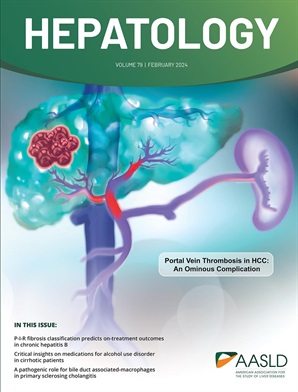免疫耐受慢性乙型肝炎的治疗。
IF 12.9
1区 医学
Q1 GASTROENTEROLOGY & HEPATOLOGY
引用次数: 0
摘要
慢性乙型肝炎(CHB)的免疫耐受期(IT)是一个独特的感染阶段,其特征是乙型肝炎病毒(HBV)复制率高,丙氨酸转氨酶(ALT)水平正常,肝脏炎症最小。尽管其被归类为良性期,但越来越多的证据挑战了这一概念,揭示了免疫激活、HBV DNA整合和潜在的致癌过程,即使在没有ALT升高的情况下。IT期的长期高病毒复制引起了人们对其对肝细胞癌(HCC)风险的关注。组织学研究表明,符合IT标准的患者可能存在明显的炎症和纤维化,这表明目前的定义可能低估了疾病的活动性。在IT期的治疗仍然存在争议,由于其有限的疗效和潜在的风险,国际指南大多建议不要使用抗病毒治疗。然而,部分IT患者可能从早期干预中获益。IT CHB治疗的风险和益处尚不完全清楚,对治疗阈值缺乏共识进一步使临床决策复杂化。这篇综述强调了重新定义IT CHB的重要性,包括病毒学和组织学参数,并呼吁进行长期研究,以阐明治疗在减少纤维化进展和HCC风险中的作用。更精确地了解IT阶段对于平衡治疗的风险和潜在益处以及为未来的治疗策略提供信息至关重要。本文章由计算机程序翻译,如有差异,请以英文原文为准。
Management of Immune Tolerant Chronic Hepatitis B.
The immune-tolerant (IT) phase of chronic hepatitis B (CHB) is a distinct stage of infection, characterized by high hepatitis B virus (HBV) replication, normal alanine aminotransferase (ALT) levels, and minimal liver inflammation. Despite its classification as a benign phase, growing evidence challenges this notion, revealing immune activation, HBV DNA integration, and potential oncogenic processes even in the absence of elevated ALT. The IT phase's prolonged high viral replication raises concerns about its implications for hepatocellular carcinoma (HCC) risk. Histological studies show that significant inflammation and fibrosis may exist in patients meeting IT criteria, suggesting that the current definitions may underestimate disease activity. Treatment during the IT phase remains controversial, with international guidelines largely recommending against antiviral therapy due to its limited efficacy and potential risks. However, subsets of IT patients may benefit from early intervention. The risks and benefits of therapy in IT CHB are not fully understood, and the lack of consensus regarding treatment thresholds further complicates clinical decision-making. This review highlights the importance of redefining IT CHB to include virological and histological parameters and calls for long-term studies to clarify the role of therapy in reducing fibrosis progression and HCC risk. A more precise understanding of the IT phase is essential to balance the risks of treatment against its potential benefits and to inform future therapeutic strategies.
求助全文
通过发布文献求助,成功后即可免费获取论文全文。
去求助
来源期刊

Hepatology
医学-胃肠肝病学
CiteScore
27.50
自引率
3.70%
发文量
609
审稿时长
1 months
期刊介绍:
HEPATOLOGY is recognized as the leading publication in the field of liver disease. It features original, peer-reviewed articles covering various aspects of liver structure, function, and disease. The journal's distinguished Editorial Board carefully selects the best articles each month, focusing on topics including immunology, chronic hepatitis, viral hepatitis, cirrhosis, genetic and metabolic liver diseases, liver cancer, and drug metabolism.
 求助内容:
求助内容: 应助结果提醒方式:
应助结果提醒方式:


